#BookScanning
Explore tagged Tumblr posts
Text
12th part of the bookscans of Al Andalus. Historical Figures, here's the previous part

Musa ben Musa ben Qasi: the third king of Spain
The Qasi were one of the most powerful families that established their possessions in the regions located between the Pyrenees and the valley of the Ebro. They were muladíes, that is, converts to Islam and descendants of that count Fortún who had already become a Mohammedan in the early days of the Arab conquest in order to maintain his fiefdom.
The history of this family, whose influence became enormous, is very intricate and it is linked to the birth of the Navarrese monarchy, with which they had blood ties. The Musa ben Musa ben Qasi of the moments in which the Navarrese kingdom begins to move , he was brother of the last Muslim governor of Pamplona, dependent of Córdoba, Mutarrif ben Musa ben Qasi. The Qasis will be loyal to the Umayyad power on some occasions, and on many other occasions they will lean towards the Navarrese or a clear dissidence, and like all great families, they will have their days of splendor and also its times of decline.
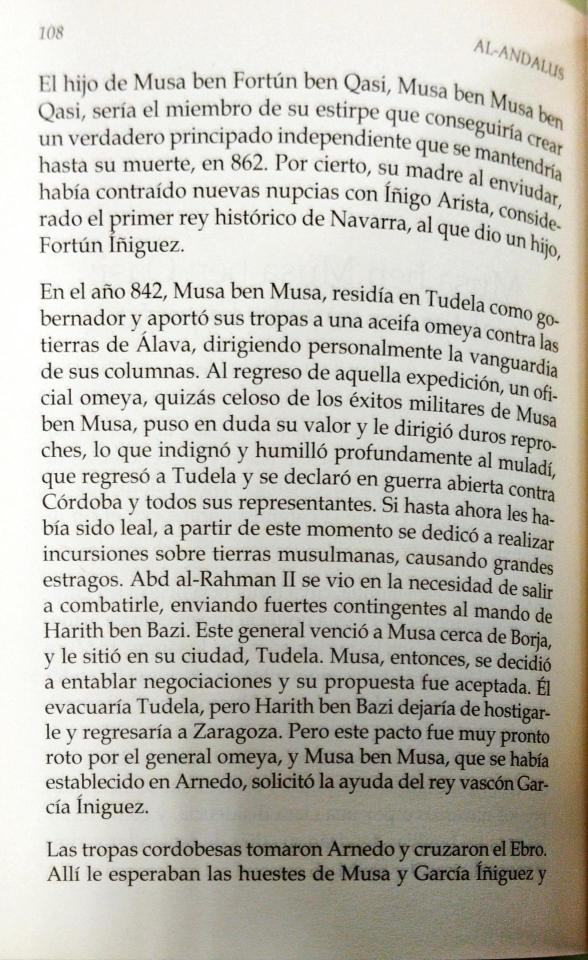
The son of Musa ben Fortún ben Qasi, Musa ben Musa ben Qasi, would be the member of his lineage who would create a true independent principality that would remain until his death, in 862. By the way, when his mother was widowed, she had remarried with Eneko Aritza, considered the first historical king of Navarra, to whom she gave a son, Fortún Íñiguez.
In the year 842, Musa ben Musa, resided in Tudela as governor and contributed his troops to an Umayyad olive tree against the lands of Álava, directing personally the vanguard of his columns. Upon return from that expedition, an Umayyad officer, perhaps jealous of the military successes of Musa ben Musa questioned his courage and reproached him harshly, which outraged and deeply humiliated the muladí, who returned to Tudela and declared opened war against Córdoba and all its representatives. If until now there had been loyal, from this moment on he dedicated himself to carrying out raids on Muslims lands, causing great havoc. Abd al-Rahman II was seen in the need to go out to fight him, sending strong contingents under the command of Harith ben Bazi. This general defeated Musa near Borja, and besieged him in his city, Tudela. Musa then decided to start negotiations and his proposal was accepted. He would evacuate Tudela, but Harith ben Bazi would stop harass him and he would return to Zaragoza. But this pact was soon broken by the Umayyad general, and Musa ben Musa, who had settled in Arnedo, requested the help of the Basque king García Íniguez.
The Cordoban troops took Arnedo and crossed the Ebro. There the soldiers were waiting for the hosts of Musa and García Íñiguez and
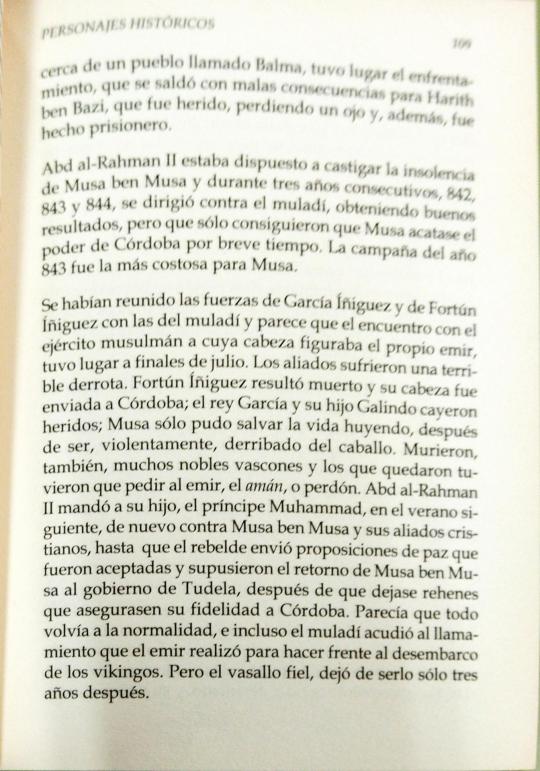
near a town called Balma, the confrontation took place, which ended with bad consequences for Harith ben Bazi, who was wounded, losing an eye and, furthermore, he was taken prisoner.
Abd al-Rahman II was ready to punish the insolence of Musa ben Musa and for three consecutive years, 842, 843 and 844, he went against the muladí, obtaining good results, but they only managed to get Musa to comply with the power of Córdoba for a short time. The campaign of the year 843 was the most costly for Musa.
The forces of García Íñiguez and Fortún Íñiguez had met with those of the muladí and it seems that the encounter with the Muslim army whose head was the emir himself, took place at the end of July. The allies suffered a terrible defeat. Fortún Íñiguez was killed and his head was sent to Córdoba; the king García and his son Galindo were wounded; Musa could only save his life by fleeing, after being violently knocked off his horse. Many also died. Basque nobles and those who remained had to ask the emir, the haman, for forgiveness. Abd al-Rahman II sent his son, Prince Muhammad, in the following summer, again against Musa ben Musa and his Christian allies, until the rebel sent peace proposals that were accepted and led to the return of Musa ben Musa to the government of Tudela, after he left hostages who ensured their loyalty to Córdoba. It seemed that everything was returning to normal, and even the muladí responded to the call that the emir made to face the landing of the Vikings. But the faithful vassal ceased to be so for only three years after.

At the death of Abd al-Rahman II, it could be said that Musa ben Musa lived and acted like a true independent prince. The new emir Muhammad I recognized the lord of Tudela as his vassal, demanding some very light signs of submission to cover appearances, signs that Musa ben Musa's benefits did not cost him anything to assume. Even the emir will commission him to wage holy war to the Hispanic March in the name of Córdoba, and to proceed in the same way with the Asturian kingdom. Furthermore, related as he was to the Navarrese dynasty, on several occasions he would be the interlocutor between Pamplona and Córdoba. He had achieved several military successes in the region of Barcelona and Lérida, making taking two Frankish counts prisoners and obtaining great loot from the assault of the Tárrega castle. He couldn't ask for more.
From then on, Musa ben Musa acquired the air of a great lord, feeling like a authentic sovereign. And since pride is something that is in every human being, he is called "the third of Spain". Of course it was to be satisfied because his undisputed dominions extended over much of the Upper March, including Zaragoza, Huesca and Tudela, but "the third king of Spain" was going, very soon, to receive a lesson in humility.
His possessions were located within the Asturian kingdom and he decided to protect them, building a stronghold, that of Albelda, very close to the current city of Logroño. When the construction was finished, perhaps around the year 859, Ordoño I, besieged it and Musa went to defend it. He had unfortunate luck, because inbconfrontation with the king of Asturias, he was seriously wounded, defeated, and his son-in-law, Garcia,
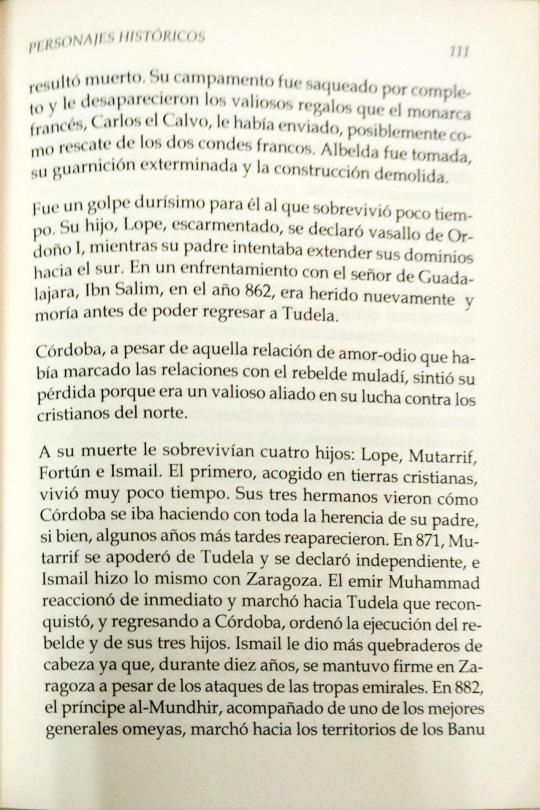
was killed. His camp was completely looted and the valuable gifts that the French monarch, Charles the Bald, had sent him disappeared, possibly as a ransom for the two Frankish counts. Albelda was taken, its garrison exterminated and construction demolished.
It was a very hard blow for him that he survived for a short time. His son, Lope, chastened, he declared himself a vassal of Ordoño l, while his father tried extend their domains to the south. In a confrontation with the lord of Guadalajara, Ibn Salim, in the year 862, he was wounded again and died before he could return to Tudela.
Córdoba, despite that love-hate relationship that had marked the relations with the muladí rebel, he felt his loss because he was a valuable ally in his fight against the Christians of the north.
At his death he was survived by four children: Lope, Mutarrif, Fortún and Ismail. First, welcomed to Christian lands, he lived for a very short time. His three brothers saw how Córdoba was taking over his father's entire inheritance, although a few more years afternoons they reappeared. In 871, Mutarrif seized Tudela and declared himself independent, and Ismail did the same with Zaragoza. Emir Muhammad reacted immediately and marched towards Tudela which he reconquered, and returning to Córdoba, he ordered the execution of the rebel and his three sons. Ismail gave him more headaches since, for ten years, he stood firm in Zaragoza despite the attacks by emiral troops. In 882, prince al-Mundhir, accompanied by one of the best Umayyad generals, marched towards the territories of the Banu
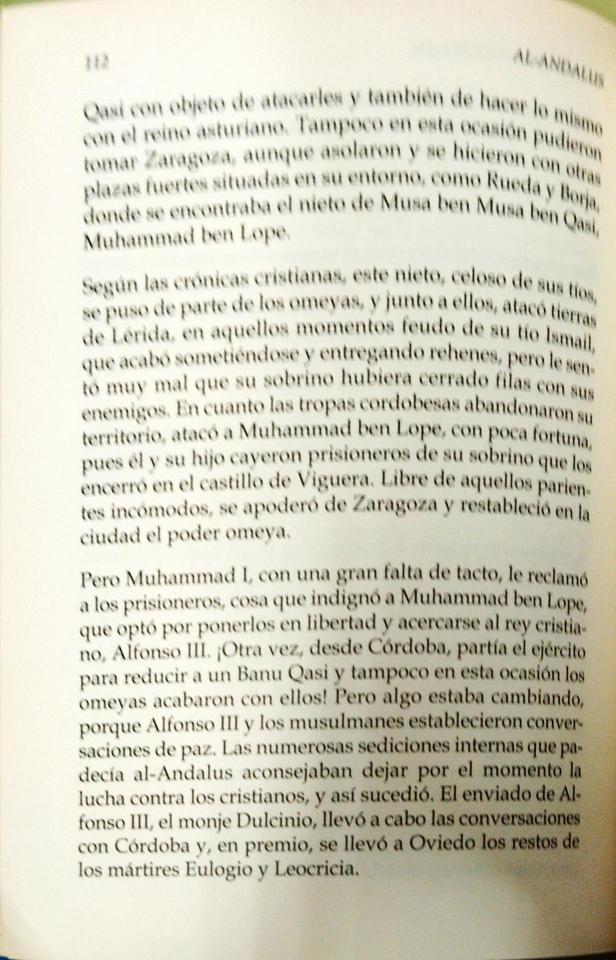
Qasi in order to attack them and also to do the same with the Asturian kingdom. Neither on this occasion could they take Zaragoza, although devastated other places located in their surroundings, such as Rueda and Borja, where Musa ben Musa ben Qasi's grandson is found, Muhammad ben Lope.
According to Christian chronicles, this grandson, jealous of his uncles, took side with the Umayyads, and together with them, he attacked the lands of Lleida, at that time a fiefdom of his uncle lsmail, who ended up submitting and handing over hostages, but he disliked that his nephew had closed ranks with his enemies. As for the Cordoban troops abandoned their territory, attacked Muhammad ben Lope, with little luck, since he and his son fell prisoners of his nephew who confine them in the castle of Viguera. Free from those uncomfortable relatives, he seized Zaragoza and reestablished Umayyad power in the city.
But Muhammad I, with great lack of tact, demanded of the prisoners, something that outraged Muhammad ben Lope, who chose to set them free and approach the Christian king, Alfonso III. Once again, from Córdoba, the army to reduce a Banu Qasi and neither on this occasion did the Umayyads finished them off. But something was changing, because Alfonso III and the Muslims established peace talks. The numerous seditions and internal affairs that al-Andalus suffered advised leaving the fight for the moment against the Christians, and so it happened. The envoy of Alfonso III, the monk Dulcinio, carried out the conversations with Córdoba and, as a reward, took to Oviedo the remains of the martyrs Eulogius and Leocricia.

After the death of Muhammad I, in the year 886, Alfonso III achieved great territorial extension at the expense of the Muslims. For almost twenty years, reconquered and repopulated large areas, especially in the valleys of the Leonese region and created new fortresses such as Burgos, Simancas, Dueñas, Toro, plus two other advanced defensive fortresses, San Esteban de Gormaz and Osma, that will pass on numerous occasions from Christian hands to Muslims, and viceversa.
Peace with the Asturian monarch had been signed, but there were still the always restless Banu Qasi. They were no longer the "third kings of Spain", but they still had power and continued to be a problem for the Umayyad power. The only surviving son of Musa ben Musa ben Qasi, Ismail, since Fortun had already deceased, settled in Lleida, around the year 884, fortifying the stronghold. In that same year, Muhammad ben Lope, who despite his attempts did not manage ally with Alfonso III, had to start thinking about guarding against another great Arab family installed in Aragon since the times of the conquest, the generally called tuchibíes. These had received the mission from Córdoba to control Muhammad ben Lope. The Tuchibi chief, Abd al-Rahman ben Abd al-Aziz, with the full consent of the emir, established garrisons south of Zaragoza, in Cala-tayud and Daroca, and Muhammad realized that, if the tuchibís loyal to Córdoba wanted, they would make his life impossible. His situation was becoming unsustainable and the solution he took is, to say the least, picturesque.
He did not evacuate the city, nor did he surrender it since he could not sustain it. No. He preferred to sell it. And who did
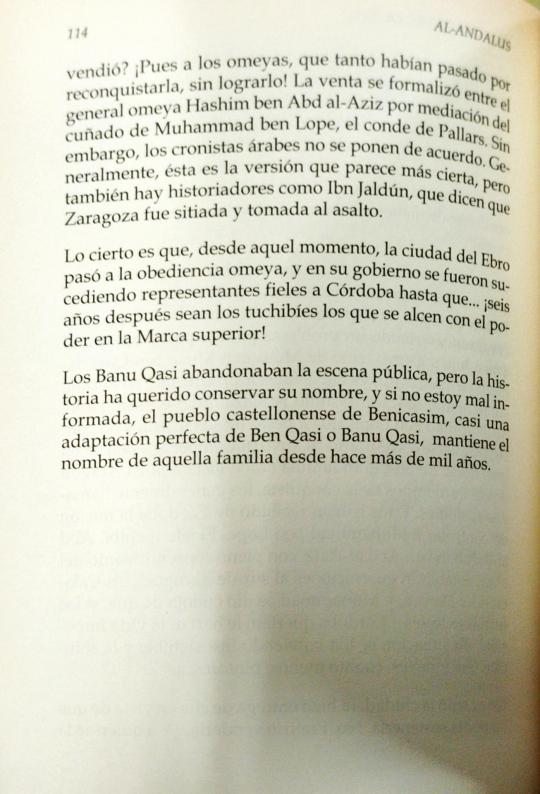
he sell It to? Well, to the Umayyads, who had gone through so much to reconquer it, without achieve it! The sale was formalized between the Umayyad general Hashim ben Abd al-Aziz through Muhammad ben Lope's brother-in-law, the Count of Pallars. However, the Arab chroniclers do not agree. Generally, this is the version that seems most true, but there are also historians like Ibn Jaldún, who say that Zaragoza was besieged and taken by storm.
The truth is that, from that moment, the city of the Ebro passed into Umayyad obedience, and in its government, representatives faithful to Córdoba succeeded until... six years later the Tuchibíes are the ones who rise to power on the Upper March!
The Banu Qasi left the public scene, but history has wanted keep their name, and if I am not misinformed, a town of Castellò, Benicasim, almost a perfect adaptation of Ben Qasi or Banu Qasi, maintains the name of that family for more than a thousand years.
#al andalus historical figures#al andalus personajes históricos#bookscans#bookblr#al andalus#al andalus history#historyblr#spanish history#banu qasi#musa ibn musa#emirate of cordoba#history#book scans
10 notes
·
View notes
Text
This Week In The Nerd Fandom: July 16th, 2023
This Week In The Nerd Fandom: July 16th, 2023 #Marvel #MsMarvel #DCComics #anime #manga #ComicBooks #LoreOlympus #SAGAFTRAstrike #SAGAFTRAstrong #SEGA #videogames
Welcome to another edition of This Week In The Nerd Fandom. Two weeks ago, we covered several of Anime Expo’s Biggest Announcements, with San Diego Comic-Con coming up on July 20th, here are this week’s biggest announcements. City Hunter The Movie: Angel Dust Scores A Limited-Western Release We're delighted to announce that we'll be bringing City Hunter the Movie: Angel Dust, the latest film…

View On WordPress
#AEGIS-CWA#Anime#Batman: Justice Buster#Circana Bookscan Chart#City Hunter The Movie: Angel Dust#Comic Books#DC Comics#Joker: One Operation Joker#Kodansha#Lore Olympus#Manga#Marvel#Ms. Marvel#Ron Kamonohashi: Deranged Detective#SAG-AFTRA#SAG-AFTRA Strike#SEGA OF AMERICA#Superman vs. Meshi: Superman no Hitori Meshi#Viz Media
6 notes
·
View notes
Text
The Bookseller: The bestselling LGBTQ+ books of the past year

For this analysis �� using data from NielsenIQ BookScan’s Total Consumer Market – we have started with the 94 titles featured in The Bookseller’s 2024 LGBTQ+ Focus issue, added in all the other books by those authors and then sifted through all the data to find anyone who might be missing. Only authors who are openly LGBTQ+ have been included in the ranking, and the scope has been limited to books by or about the queer community, meaning that while Cher’s biography might have been the campest thing in the charts last Christmas, it does not feature in this ranking. Also, bestselling books which feature LGBTQ+ representation through minor characters – such as Katie Kirby’s The Majorly Awkward BFF Dramas of Lottie Brooks, which features a subplot with a gay character that is not the main focus of the book – are also excluded. Those parameters throw up a Top 50 that has earned £20.6m across 2.2 million books – roughly a fifth of the overall TCM Top 50 in the same period, which sold 10.6 million books in the same period. Topping the Queer Top 50 is Pinch of Nom: Air Fryer by married couple Kay and Kate Allinson, swiftly followed by their latest offering Pinch of Nom: All in One. The Allinsons account for 20.4% of the total value and bookend the Top 50, with Pinch of Nom Express taking the 50th position. Additionally, the chefs’ air-fryer-inspired recipes are the only book to feature in both the LGBTQ+ Top 50 and the TCM Top 50 in the last year. In total, there are nine Non-Fiction titles in the chart and six from the Children’s sector – including one World Book Day title – with Fiction taking up most of the chart with 35 entries bringing in £11.7m. The biggest of these is Jacqueline Wilson’s Think Again – an adult continuation of her bestselling Girls series – the hardback of which sold 69,712 copies and is the only fiction book to earn more than £1m in this chart. It is perhaps no surprise that most of the books on the list are from the last five years, with the vast majority coming from this century – only Bret Easton Ellis’ American Psycho and James Baldwin’s Giovanni’s Room represent the 20th century, while Oscar Wilde’s The Picture of Dorian Gray is the sole representative of the 1800s. (Full article)
#literature#lit#gay literature#lgbt literature#lgbtq literature#books#bookblr#gay#lgbt#lgbtq#lgbtqia
46 notes
·
View notes
Text
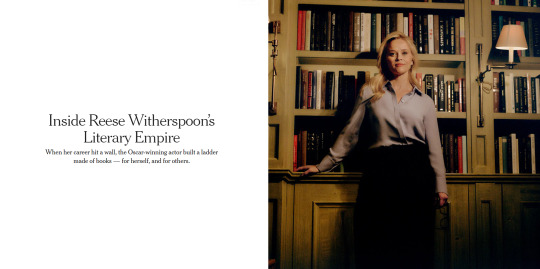
By Elisabeth Egan May 18, 2024
“You’d be shocked by how many books have women chained in basements,” Reese Witherspoon said. “I know it happens in the world. I don’t want to read a book about it.”
Nor does she want to read an academic treatise, or a 700-page novel about a tree.
Sitting in her office in Nashville, occasionally dipping into a box of takeout nachos, Witherspoon talked about what she does like to read — and what she looks for in a selection for Reese’s Book Club, which she referred to in a crisp third person.
“It needs to be optimistic,” Witherspoon said. “It needs to be shareable. Do you close this book and say, ‘I know exactly who I want to give it to?’”
But, first and foremost, she wants books by women, with women at the center of the action who save themselves. “Because that’s what women do,” she said. “No one’s coming to save us.”
Witherspoon, 48, has now been a presence in the book world for a decade. Her productions of novels like “Big Little Lies,” “Little Fires Everywhere” and “The Last Thing He Told Me” are foundations of the binge-watching canon. Her book club picks reliably land on the best-seller list for weeks, months or, in the case of “Where the Crawdads Sing,” years. In 2023, print sales for the club’s selections outpaced those of Oprah’s Book Club and Read With Jenna, according to Circana Bookscan, adding up to 2.3 million copies sold.
So how did an actor who dropped out of college (fine, Stanford) become one of the most influential people in an industry known for being intractable and slightly tweedy?
It started with Witherspoon’s frustration over the film industry’s skimpy representation of women onscreen — especially seasoned, strong, smart, brave, mysterious, complicated and, yes, dangerous women.
“When I was about 34, I stopped reading interesting scripts,” she said.
Witherspoon had already made a name for herself with “Election,” “Legally Blonde” and “Walk the Line.” But, by 2010, Hollywood was in flux: Streaming services were gaining traction. DVDs were following VHS tapes to the land of forgotten technology.
“When there’s a big economic shift in the media business, it’s not the superhero movies or independent films we lose out on,” Witherspoon said. “It’s the middle, which is usually where women live. The family drama. The romantic comedy. So I decided to fund a company to make those kinds of movies.”
In 2012, she started the production company Pacific Standard with Bruna Papandrea. Its first projects were film adaptations of books: “Gone Girl” and “Wild,” which both opened in theaters in 2014.
Growing up in Nashville, Witherspoon knew the value of a library card. She caught the bug early, she said, from her grandmother, Dorothea Draper Witherspoon, who taught first grade and devoured Danielle Steel novels in a “big cozy lounger” while sipping iced tea from a glass “with a little paper towel wrapped around it.”
This attention to detail is a smoke signal of sorts: Witherspoon is a person of words.
When she was in high school, Witherspoon stayed after class to badger her English teacher — Margaret Renkl, now a contributing opinion writer for The New York Times — about books that weren’t part of the curriculum. When Witherspoon first moved to Los Angeles, books helped prepare her for the “chaos” of filmmaking; “The Making of the African Queen” by Katharine Hepburn was a particular favorite.
So it made sense that, as soon as Witherspoon joined Instagram, she started sharing book recommendations. Authors were tickled and readers shopped accordingly. In 2017, Witherspoon made it official: Reese’s Book Club became a part of her new company, Hello Sunshine.
The timing was fortuitous, according to Pamela Dorman, senior vice president and publisher of Pamela Dorman Books/Viking, who edited the club’s inaugural pick, “Eleanor Oliphant is Completely Fine.” “The book world needed something to help boost sales in a new way,” she said.
Reese’s Book Club was that something: “Eleanor Oliphant” spent 85 weeks on the paperback best-seller list. The club’s second pick, “The Alice Network,” spent nearly four months on the weekly best-seller lists and two months on the audio list. Its third, “The Lying Game,” spent 18 weeks on the weekly lists.
“There’s nothing better than getting that phone call,” added Dorman, who has now edited two more Reese’s Book Club selections.
Kiley Reid’s debut novel, “Such a Fun Age,” got the nod in January 2020. She said, “When I was on book tour, a lot of women would tell me, ‘I haven’t read a book in four years, but I trust Reese.’” Four years later, on tour for her second novel, “Come and Get It,” Reid met women who were reading 100 books a year.
Witherspoon tapped into a sweet spot between literary and commercial fiction, with a few essay collections and memoirs sprinkled in. She turned out to be the literary equivalent of a fit model — a reliable bellwether for readers in search of intelligent, discussion-worthy fare, hold the Proust. She wanted to help narrow down the choices for busy readers, she said, “to bring the book club out of your grandma’s living room and online.”
She added: “The unexpected piece of it all was the economic impact on these authors’ lives.”
One writer became the first person in her family to own a home. “She texted me a picture of the key,” Witherspoon said. “I burst into tears.”
Witherspoon considers a handful of books each month. Submissions from publishers are culled by a small group that includes Sarah Harden, chief executive of Hello Sunshine; Gretchen Schreiber, manager of books (her original title was “bookworm”); and Jon Baker, whose team at Baker Literary Scouting scours the market for promising manuscripts.
Not only is Witherspoon focused on stories by women — “the Bechdel test writ large,” Baker said — but also, “Nothing makes her happier than getting something out in the world that you might not see otherwise.”
When transgender rights were in the headlines in 2018, the club chose “This Is How It Always Is,” Laurie Frankel’s novel about a family grappling with related issues in the petri dish of their own home. “We track the long tail of our book club picks and this one, without fail, continues to sell,” Baker said.
Witherspoon’s early readers look for a balance of voices, backgrounds and experiences. They also pay attention to the calendar. “Everyone knows December and May are the busiest months for women,” Harden said, referring to the mad rush of the holidays and the end of the school year. “You don’t want to read a literary doorstop then. What do you want to read on summer break? What do you want to read in January?”
Occasionally the group chooses a book that isn’t brand-new, as with the club’s April pick, “The Most Fun We Ever Had,” from 2019. When Claire Lombardo learned that her almost-five-year-old novel had been anointed, she thought there had been a mistake; after all, her new book, “Same As it Ever Was,” is coming out next month. “It’s wild,” Lombardo said. “It’s not something that I was expecting.”
Sales of “The Most Fun We Ever Had” increased by 10,000 percent after the announcement, according to Doubleday. Within the first two weeks, 27,000 copies were sold. The book has been optioned by Hello Sunshine.
Witherspoon preferred not to elaborate on a few subjects: competition with other top-shelf book clubs (“We try not to pick the same books”); the lone author who declined to be part of hers (“I have a lot of respect for her clarity”); and the 2025 book she’s already called dibs on (“You can’t imagine that Edith Wharton or Graham Greene didn’t write it”).
But she was eager to set the record straight on two fronts. Her team doesn’t get the rights to every book — “It’s just how the cookie crumbles,” she said — and, Reese’s Book Club doesn’t make money off sales of its picks. Earnings come from brand collaborations and affiliate revenue.
This is true of all celebrity book clubs. An endorsement from one of them is a free shot of publicity, but one might argue that Reese’s Book Club does a bit more for its books and authors than most. Not only does it promote each book from hardcover to paperback, it supports authors in subsequent phases of their careers.
Take Reid, for instance. More than three years after Reese’s Book Club picked her first novel, it hosted a cover reveal for “Come and Get It,” which came out in January. This isn’t the same as a yellow seal on the cover, but it’s still a spotlight with the potential to be seen by the club’s 2.9 million Instagram followers.
“I definitely felt like I was joining a very large community,” Reid said.
“Alum” writers tend to stay connected with one another via social media, swapping woot woots and advice. They’re also invited to participate in Hello Sunshine events and Lit Up, a mentorship program for underrepresented writers. Participants get editing and coaching from Reese’s Book Club authors, plus a marketing commitment from the club when their manuscripts are submitted to agents and editors.
“I describe publishing and where we sit in terms of being on a river,” Schreiber said. “We’re downstream; we’re looking at what they’re picking. Lit Up gave us the ability to look upstream and say, ‘We’d like to make a change here.’”
The first Lit Up-incubated novel, “Time and Time Again” by Chatham Greenfield, is coming out from Bloomsbury YA in July. Five more fellows have announced the sales of their books.
As Reese’s Book Club approaches a milestone — the 100th pick, to be announced in September — it continues to adapt to changes in the market. Print sales for club selections peaked at five million in 2020, and they’ve softened since then, according to Circana Bookscan. In 2021, Candle Media, a Blackstone-backed media company, bought Hello Sunshine for $900 million. Witherspoon is a member of Candle Media’s board. She is currently co-producing a “Legally Blonde” prequel series for Amazon Prime Video.
This month, Reese’s Book Club will unveil an exclusive audio partnership with Apple, allowing readers to find all the picks in one place on the Apple Books app. “I want people to stop saying, ‘I didn’t really read it, I just listened,’” Witherspoon said. “Stop that. If you listened, you read it. There’s no right way to absorb a book.”
She feels that Hollywood has changed over the years: “Consumers are more discerning about wanting to hear stories that are generated by a woman.”
Even as she’s looking forward, Witherspoon remembers her grandmother, the one who set her on this path.
“Somebody came up to me at the gym the other day and he said” — here she put on a gentle Southern drawl — “‘I’m going to tell you something I bet you didn’t hear today.’ And he goes, ‘Your grandma taught me how to read.’”
Another smoke signal, and a reminder of what lives on.
#reese witherspoon#reese's book club#reading#literary#club#book#new york times#elisabeth egan#article
197 notes
·
View notes
Text
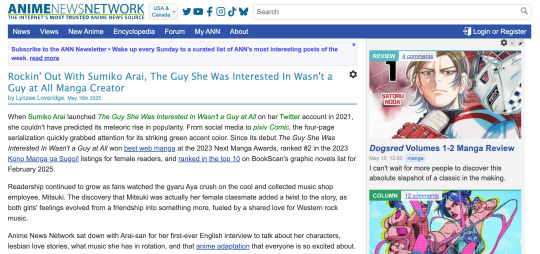
Sumiko's first-ever English interview is with Anime News Network.
(full interview below in case the link dies)
Rockin' Out With Sumiko Arai, The Guy She Was Interested In Wasn't a Guy at All Manga Creator by Lynzee Loveridge, May 16th 2025
When Sumiko Arai launched The Guy She Was Interested In Wasn't a Guy at All on her Twitter account in 2021, she couldn't have predicted its meteoric rise in popularity. From social media to pixiv Comic, the four-page serialization quickly grabbed attention for its striking green accent color. Since its debut The Guy She Was Interested In Wasn't a Guy at All won best web manga at the 2023 Next Manga Awards, ranked #2 in the 2023 Kono Manga ga Sugoi! listings for female readers, and ranked in the top 10 on BookScan's graphic novels list for February 2025.
Readership continued to grow as fans watched the gyaru Aya crush on the cool and collected music shop employee, Mitsuki. The discovery that Mitsuki was actually her female classmate added a twist to the story, as both girls' feelings evolved from a friendship into something more, fueled by a shared love for Western rock music.
Anime News Network sat down with Arai-san for her first-ever English interview to talk about her characters, lesbian love stories, what music she has in rotation, and that anime adaptation that everyone is so excited about.
Can you discuss designing the lead characters, Aya and Mitsuki? When it came to capturing Mitsuki's coolness, who or what might have been your inspiration?
Sumiko Arai: I took the most extroverted side of myself and kind of amplified it and put it into Aya, and then took the most introverted side of myself and put it into Mitsuki. I think that's the two very different sides of myself turned into characters, and I think I understand them that way the best. I really have loved polar-opposite kind of pairings in any story, and that's just always been something I wanted to write.
Are there other fictional couples that represent a similar hot-cold to you, even if they don't directly inspire Aya and Mitsuki?
Sumiko Arai: Okay. Well, I mean, obviously, this is in a completely different setting, but I loved Shelby and Toni from The Wilds. That was something that I was watching when I created these characters, but it's completely different. I just like their dynamic a lot.
Can you share your artistic journey with us? When did you first begin drawing, and what appealed to you about telling stories through the comic book medium?
Sumiko Arai: I started drawing at a younger age, but I always grew up with manga. I didn't really think that I would be doing this in the future. I just really liked the art and the pretty things in there, and I just tried to copy it and get better at it. So that was kind of my journey with art, and I think with comics, you know, a lot of Japanese kids aspire to be something like that. It's really, it's a really cool job. But I think what's really appealing about comics, in general, is that you feel more personal with all the characters because there's a visual attached to it. And that's how I felt.
I can retain information better. I feel like I can relate to the characters better because I see them visually, and I see their expressions; it kind of helps me out. I'm not a big book reader, you know? Even the most mundane kind of dialogue can be made into a very impactful scene just by it being paired with this expression of a character. That's what makes it beautiful.
Some moments are just completely different when you can see the reactions on the characters' faces compared to what you may envision if you're reading it in book form. That art really sticks with you. And there are certain visual images in manga and comic books that I think have almost become pop culture images that we all associate with.
Sumiko Arai: Oh yeah, for sure. Yeah. That's so cool.
Your manga has a unique publishing format, and each chapter is released in about four pages, which I think is how it originally debuted on social media. Is this format challenging for the storytelling that you come up with because you're restricted within four pages?
Sumiko Arai: So personally, I think that longer formats would be more intimidating for me now. I feel like I'm more used to the short format. I think it's kind of hard to put out four pages and be like, “Oh, please be sufficed by this.” Everyone wants to read a little more every week, but the challenge is that I have to cut a lot of dialogue or little details that I would put in there if it were longer. I have to make sure that it's short and concise and has a rhythm of its own, I guess, so that everyone can get the information and message they need from the chapter. But I think I like the format. I think even though it's kind of frustrating sometimes, to keep it short.
There are dramatic beats that the characters hit at various points. Is the format harder for that, or is it because it has its own rhythm already, and you're so accustomed to it that it works?
Sumiko Arai: Yeah, it works now. I think it was harder before, but I'm definitely more satisfied with it now.
Western music plays an important role in connecting Aya and Mitsuki. Is there a Western music album that played an important role in your life in a similar way? And is there an album you think you've listened to the most?
Sumiko Arai: So I grew up with a lot of foreign music because of my dad when I was little. He introduced me to Beck when I was a kid. And I really loved Beck's album Guero. It's the album with the white, red, and black cover. But it's really cool. I think that's the album that's my lifetime favorite.
But for music or albums that I've listened to a lot, like, front to back, I have a couple. Not necessarily rock, you know, I feel like I listen to other genres, too. Can I list them all?
Sure!
Sumiko Arai: I've always listened to the Beatles a lot, and Revolver is a big one, and Deftones. Around the Fur is a really good album. I think in my teen years, I listened to a lot of Half Moon Run, so Dark Eyes is a really good album. And a lot of Clairo. A lot.
Those aren't all rock bands, are they?
Sumiko Arai: I think some may be folk, kind of folky. I think Half Moon Run is a little more pop-folk. I mean, I'm kind of all over the place a little bit.
In your opinion, how can music benefit people who relate to Mitsuki? People who have a "different rhythm?"
Sumiko Arai: I think that when you're feeling a certain way, you feel like you can relate to this piece of music that someone you don't know wrote and have a shoulder to lean on a little bit. It's like a friend that you don't really have who understands it completely. I think in that way, it really does benefit you. But also, one song is all it takes for you to find a community that really likes the type of stuff that you like and can relate to. I think that's how music can be really beneficial.
It's a great way to connect people.
Sumiko Arai: Yeah, yeah. To find a community, you know, and see that you aren't really alone in this world at all.
Were you already a fan of yuri stories before you started The Guy She Was Interested In Wasn't a Guy at All? What do you think makes yuri manga special?
Sumiko Arai: So I like yuri, but I was like always scouring the internet for any type of queer, like woman-loving-woman series or movies, because there really aren't much to watch. I've always been searching for something that I can relate to; I was a fan. I definitely saw a lack [of options] in it, so I wanted to make something to contribute, maybe. But just woman-loving-woman [media] in general is unique and special as it is, and I think that's what I love about it.
What were your feelings when it was announced that your manga would get an anime adaptation? Can you share if the color green might play an important role in the anime's visuals?
Sumiko Arai: I was very excited. Very excited. I really wanted to get the information out there to the readers because I had been seeing some people talk about it as something they wished would happen, and it's hard to know that information and not be able to say anything.
People are tweeting, “Oh, I hope this becomes anime,” and you know it will.
Sumiko Arai: Yeah, I was really pumped to get it out and to see everyone's reaction. It was very warm. That was great. Unfortunately, I can't say anything about the visuals at the moment, but I'm really hoping I can share some things soon.
Is there any importance to the specific songs that Aya and Mitsuki listen to together throughout the series? Do they represent a progression in their relationship?
Sumiko Arai: Yeah, I think some of them do. Some of them are just, you know, songs that they're listening to at that time and want to share with other people. But I think a lot of the time, I think about their headspace and what they're feeling at that moment, and try to find a song that fits them. Sometimes, stories come to me through listening to that song, and I think that's what's really special about this comic.
I saw they ended up making an official playlist for the series.
Sumiko Arai: It's on Spotify, Apple Music, and everything. That is the official playlist that I picked out the music for the series, but the premise is that the characters picked it, and I think that's what makes it kind of personal.
My last question is, what five music artists or songs are currently in your playlist?
Sumiko Arai: Okay, let's see. I am currently listening to Bloc Party and The Hives. I am also listening to Cream; I'm kind of all over the place.
Cream, Like Eric Clapton Cream?
Sumiko Arai: Yeah. And what else do I have? I have always loved Car Seat Headrest. They're gonna put their new album out soon, so I'm kind of pumped for that. And one more, The Cure.
The Cure is on permanent rotation, I think, right?
Sumiko Arai: Yeah, always, always.
The Guy She Was Interested In Wasn't a Guy at All manga is available in English from Yen Press. Yen Press will release the third volume on October 25, 2025.
Disclosure: Kadokawa World Entertainment (KWE), a wholly owned subsidiary of Kadokawa Corporation, is the majority owner of Anime News Network, LLC. Yen Press, BookWalker Global, and J-Novel Club are subsidiaries of KWE.
#the guy she was interested in wasn't a guy at all#sumiko arai#green manga#tgswiiwagaa#kinioto#yuri#manga#the link looks dead but I pulled the text from the waybackmachine
15 notes
·
View notes
Text
come home to my heart: january
hello, sweet online friends. it's me, riley. time rolls on. a new year begins. my next book, somehow, is only ~3 months from hitting shelves (May 6), and so pre-release season is ramping up!
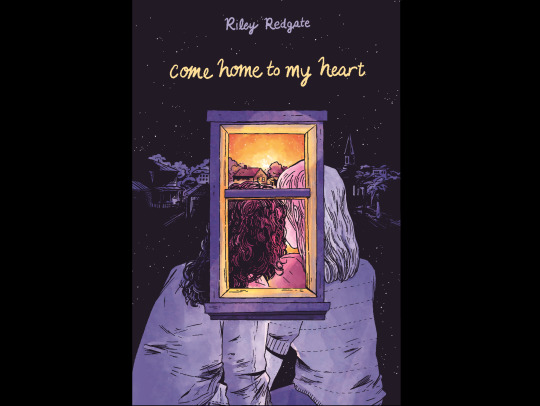
all i can really say is that since i wrote the original draft of this book in 2019, this project has only felt more and more urgent to me. it's a book about finding solace, love, and community where you can as a young queer person. i hope everybody reading this has an abundance of all three.
i've never cross-posted reviews of my books before, but the early reactions to this book have really touched me. i feel like they describe the project more eloquently & earnestly than i could:
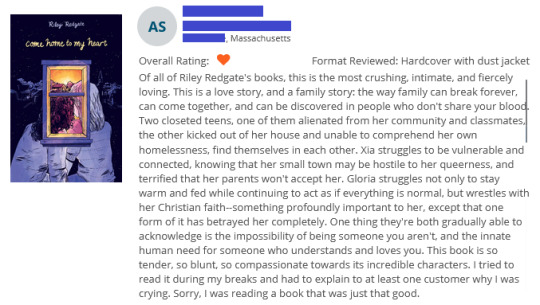

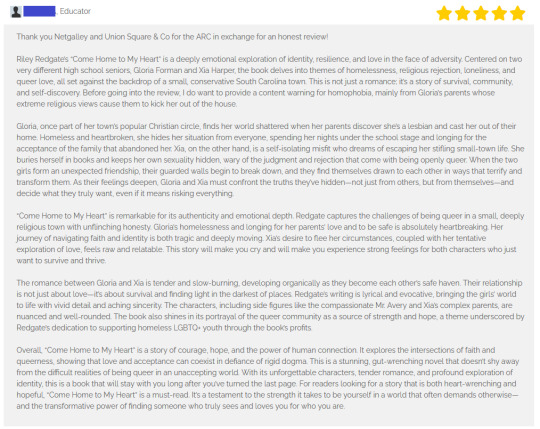
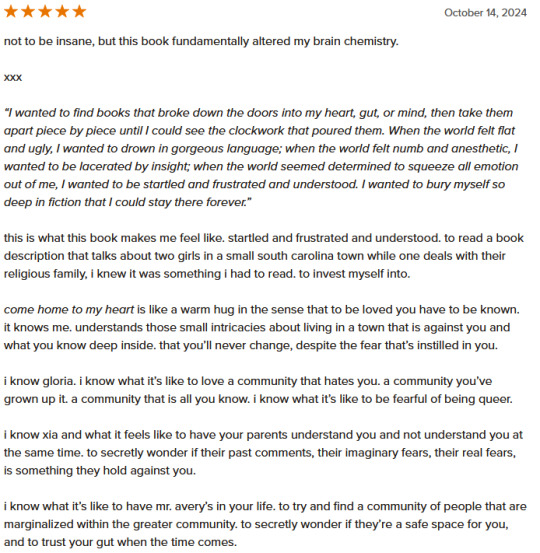
since i am but a lowly midlist author, daily refreshing my bookscan numbers and full-body wincing, every preorder continues to matter enormously to my writing career! preorders are available through:
bookshop.org
your local indie
barnes & noble
books-a-million
amazon
you can also request to read it early from:
netgalley
edelweiss
if you know Come Home is not your kind of book, but would like to help it find its audience, the following things would mean the world:
reblogging this post!
requesting that your library carry it (if you have the Libby app, you can do this in 30 seconds by searching for the book, tapping 'Deep Search,' and then hitting 'Notify Me')
telling any librarians, booksellers, or teachers you know about it
mentioning the book on social media--Reddit, TikTok, Instagram, anything
mentioning the book to other readers, especially young readers
gifting the book to somebody you think might like it
part of the royalties from the book will be donated to the following amazing LGBTQ+ and housing-focused organizations:
Covenant House
The Relatives
North Star
The Harriet Hancock Center
The Night Ministry
ok. i'll be back sometime in february with more. i know there's a goodreads giveaway in the pipeline, and i'll post some excerpts. probably trade reviews will start trickling in too, so i'll hold my breath with terror or whatever and keep you posted. <3
with love, riley
33 notes
·
View notes
Text
In my news today.
Scholastic reports that SUNRISE ON THE REAPING, the new Hunger Games prequel by Suzanne Collins, sold 1.5 million English-language units across all formats in its first week, with US sales exceeding 1.2 million units. Circana Bookscan shows that this includes nearly 715,000 hardcovers in the US and Nielsen Bookscan tracked sales of just over 118,000 hardcovers in the UK. Scholastic writes in a release, "Sunrise on the Reaping has sold twice as many copies its first week on sale domestically as The Ballad of Songbirds and Snakes in 2019 and three times as many copies as Mockingjay in 2010." Elie Berger, evp, president, Scholastic Trade, said, "After nearly a year of anticipation, sales for Sunrise on the Reaping have exceeded all expectations, as has the overwhelmingly positive critical and fan response to the book across the world."
We did it, nerds. Scholastic will definitely be asking her for more books.
#publishing news#sunrise on the reaping#the ballad of songbirds and snakes#mockingjay#suzanne collins#scholastic#scholastic press#thg series
11 notes
·
View notes
Text

Spare by Prince Harry, was crowned number one in both the Audible and Nielsen BookScan charts last year.

It also appeared in Bookstat’s top 20 e-books for 2023”
#prince harry#the duke of sussex#duke of sussex#Prince Harry the duke of Sussex#spare by prince harry#british royals#british royal family
23 notes
·
View notes
Text
The Manga Review: Lions and Lambs
Circana Bookscan just published sales data for February 2025, and once again VIZ, Yen, and Dark Horse dominate the Top 20 Adult Graphic Novels List. As Brigid Alverson observes, this is the “second month in a row” that the list “consists entirely of manga and manhwa.” Many of the titles on the list are perennial best-sellers—Berserk, Jujutsu Kaisen, My Hero Academia, Solo Leveling—but there are a…
3 notes
·
View notes
Note
With the NYT best seller list only being the top ten books in age categories, if an author were close to the NYT best seller list but couldn't quite crack it.. would they ever know? Like, say their book was #13 in the country for sales.. is there even a way to know?
You're starting with a misconception here. First, the NYT isn't the "top 10 books in age categories" -- it's a curated list calculated using a proprietary algorithm to determine what THEY call "NYT Bestsellers." (And some of those categories also have 15! For some reason!) We can't know what numbers they are really looking at, where they really get them, how they weigh them, what kinds of books they eliminate, or what other factors might go into it -- but I assure you it's NOT actually about "what sold the most."
That means there IS no "#13" because how the list is created is not based on like, reality, actual numbers, it's a curated thing. I have certainly have had books that, according to BookScan, sold MORE than the #10 NYT book in a given week, but didn't list at all. And I've seen books that, on the face of it, should NOT have listed just based on the numbers, but did. So... ????
But sure - if you were selling well enough that you were even in contention, you'd probably know it because your publisher would be excited, and everyone would be telling you "your book is doing amazing!", and you probably would have hit ONE of the Bestseller Lists, if not NYT!
If you are interested in getting deeper on this, by way of illustration, I'm comparing several Number 13s vs the NYT and each other:
-- BookScan Overall: (Top 100 books sold overall in the country last week just by the numbers, old books and new books combined, all formats, not narrowed down by any category at all): #13 of ALL books sold last week was a cookbook called OPEN WIDE -- that's also #6 on the NYT "Advice / How To / Misc" list, and #7 on the USA Today list, not on the Indie list.
-- USA Today Bestseller List: (Curated list of top 150 books overall sold): #13 is TABLE FOR TWO: FICTIONS - This is #31 on the BookScan Overall list, not on the NYT List at all (though I'm sure it has been), #3 on the Indie Hardcover Fiction list.
-- Indie Bestseller Lists: (counting indie bookstores only, top 15 divided into broad categories) Adult Fiction #13 - IRON FLAME. That is #28 on Bookscan overall - also #28 on the USA Today, #11 on NYT Adult Combined Print + Ebook Fiction, but does not appear on NYT Adult Hardcover.
Now to just dip a TOE on to the kids book side: The #1 NYT Picture Book this week is WHAT DO YOU DO WITH AN IDEA? -- This book does not appear on the BookScan Overall top 100, or the USA Today, or the indie PB list. What's up with that? IDK! But food for thought, eh?
11 notes
·
View notes
Text
Also related with the second part of the bookscans, I would like to add some pictures of the first gold dinars of Al Andalus, the transitional coins during the conquest of the Iberian Peninsula. They are from the years 712/713 (94 of Hegira) and 716/717 (98 of Hegira), the first ones have Latin characters, but the last ones are bilingual, and are in both Arabic and Latin:

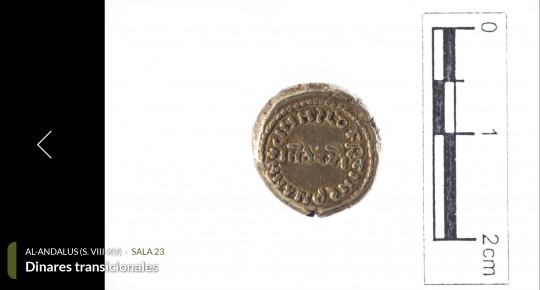
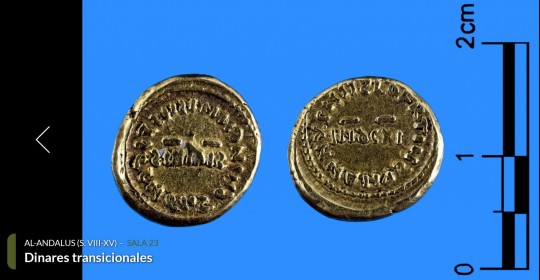
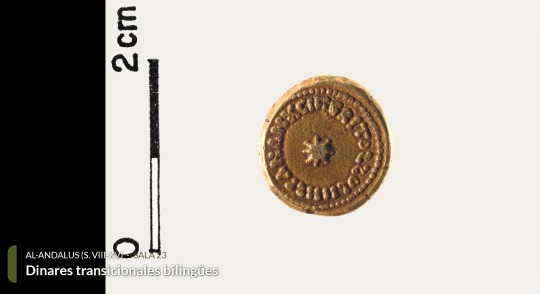
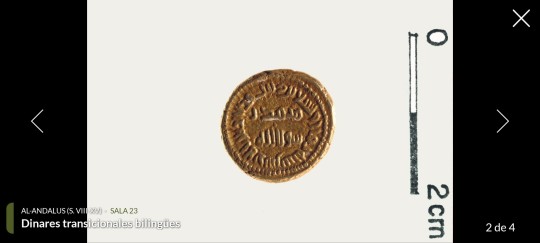
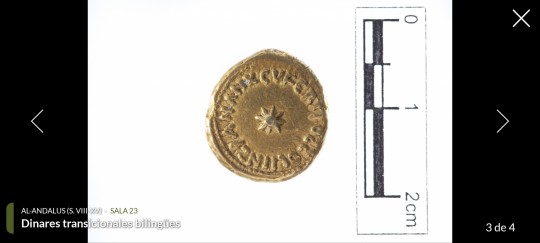
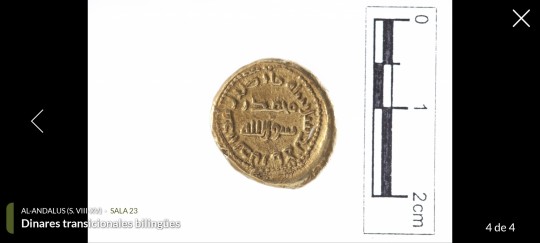
These are from the Al-Andalus' section of the Spanish National Archaeological Museum, concretely I got the pictures from the museum's free app (the app is mainly a virtual tour inside the museum that offers a close-up of the exhibits)
Bonus track: A map of the conquest
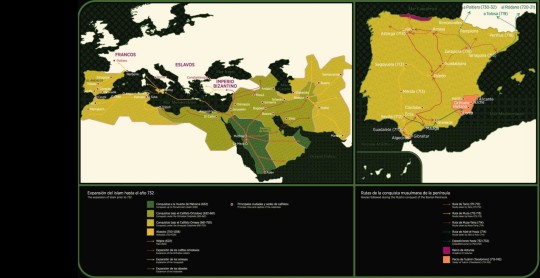
#al andalus#book scans#al andalus history#al andalus. historical figures#al andalus personajes históricos#historyblr#bookscans related#spanish history#coins#dinar#8th century#arqueology
11 notes
·
View notes
Text
Solo Leveling Takes The Lead In Circana's Top 20 Adult Graphic Novels for February #Manga #GraphicNovels #SoloLeveling #ChainsawMan #MyHeroAcademia #DanDaDan #DemonSlayer #Books
#Anime#Berserk#Books#Chainsaw Man#Circana Bookscan Chart#Dandadan#Demon Slayer Kimetsu No Yaiba#Frieren: Beyond Journey&039;s End#Graphic Novels#Jujutsu Kaisen#Kagurabachi#Kaiju No. 8#Manga#Manhwa#My Hero Academia#One Piece#Solo Leveling#Spy x Family#The Guy She Was Interested In Wasnt A Guy At All
0 notes
Text

Manga continues to drive graphic novel sales, making up 16 of the Top 20 best-selling adult graphic novels for December 2024, according to Circana BookScan.
#JujutsuKaisen leads the pack with Volume 24 at #1 and Volume 1 at #3, alongside two other volumes. Other notable entries include #Dandadan, One-Piece, #SoloLeveling, and Demon Slayer. Three deluxe Berserk volumes also made the list, reflecting sustained demand for the series. VIZ Media’s new hit Kagurabachi Volume 1 returned to the chart, landing at #18.
2 notes
·
View notes
Text
The Scourge of the "Comparable Title"
by John Merrick (excerpted from "Why Are Books So Boring Now?" at Eurozine)
The divide between popularity and prestige was always present in publishing but, [Dan] Sinykin [author of Big Fiction: How Conglomerates Changed the Publishing Industry and American Literature] argues, the conglomerate era has seen it grow wider. Where once a novel like E. L. Doctorow’s formally innovative Ragtime could hold its own as the year’s biggest title, as it did in 1975, those who came out on top in this new world were a different kind of name brand author. The 1980s and 1990s saw authors like Danielle Steel, Stephen King, Tom Clancy and Michael Crichton gain ascendancy, expected to churn out a blockbuster a year with work that tended to incorporate the conventions of genre fiction.
Today’s biggest sellers are no different. Recent years have seen the dominance of young adult romance writer Colleen Hoover (six of the UK’s 50 top-selling books of 2023), Richard Osman’s gentle crime books (four of the top 50), and J. K. Rowling (whose Harry Potter series has provided the best-selling book of the year nine times since 1998). Alongside these commercial giants are big sellers from those famous in other fields: 2023’s overall highest seller was Prince Harry’s memoir, Spare.
In the editorial meetings where what is published is decided and why, the most enduring effect has been the dominance of the ‘comparable title’. Comps, as they are known, are the system whereby newly acquired titles are judged by reference to the sales of older, similar books. Although a long-standing practice, it wasn’t until the introduction of BookScan in 2001, and with it the ready availability of accurate industry-wide sales figures, that they gained a new kind of dominance.
For an editor to acquire a book today, a list of comps will need to be drawn up, their sales figures high enough for a book to break even. The book will then be scrutinized by the marketing, publicity and sales departments, where the author’s ability to discuss their work on TV or podcasts is evaluated, their social media followings judged and the chances of review coverage assessed.
This situation has been greatly accelerated by changes beyond the publishing houses. It is Sinykin’s great merit that he looks at the wider economic conditions, including the rise of retail chains, the growth of wholesalers, and with them more complex and reactive distribution chains, along with the diminishing influence of book reviews and the rise of Amazon.
Now more than ever, the journey of a book from the writer’s desk to the reader’s hands is a complex one. Joining the acquiring editor in shaping it is the agent, the publicist, the marketer, the subsidiary rights specialist and the social media manager, as well as booksellers, book buyers, wholesalers – and, somewhere behind all of this, the shareholder. Each of these has different, sometimes competing, interests and expectations.
#writeblr#writing#publishing#writing advice#writing tips#novel writing#indie author#self publishing#publishing industry#writing industry#professional writing#dan sinykin#john merrick#come together#literature#media conglomerate#media consumption#eurozine
1 note
·
View note
Text
A 'renaissance of gay literature' marks a turning point for publishing

In the 12-month period ending in October 2023, LGBTQ fiction sales reached 4.4 million units, up 7% from the prior 12-month period and 200% from the 12-month period ending in October 2019, according to exclusive data provided to NBC News by Circana BookScan. In contrast, the data showed that total fiction sales were down 3% in that latest year-over-year time period and up just 27% in the four-year span. “There’s been LGBTQIA fiction forever, but what really makes this different over the last five years is that those storylines have been moving from a more niche area of fiction into the mainstream,” Kristen McLean, Circana’s lead book industry analyst, told NBC News of what she calls a “generational story.” In June, Circana reported that romance titles accounted for 30% of the uptick in LGBTQ fiction sales, and, according to Circana’s data for NBC News, romance was among the highest-selling LGBTQ categories in both adult and young adult fiction as of the end of October. (Full article)
Quite interesting data. I hope this leads to a growing interest in old gems too (*coughcough* like Wingmen, The Charioteer and David Blaize *coughcough*).
#gay literature#lgbt literature#lgbtq literature#literature#lit#gay books#books#bookblr#gay#lgbt#lgbtq
8 notes
·
View notes
Quote
How many books are sold in the United States? The only tracker we have is BookScan, which logs point of sale—i.e., customer purchases at stores, websites, etc.—for most of the market. BookScan counted 767 million print sales in 2023. BookScan claims to cover 85% of print sales, although many in publishing think it’s much less. It does not capture all store sales, any library sales, most festival and reading sales, etc. (Almost every author will tell you their royalty reports show significantly more sales than BookScan captures. Sometimes by orders of magnitude.)
Yes, People Do Buy Books
2 notes
·
View notes